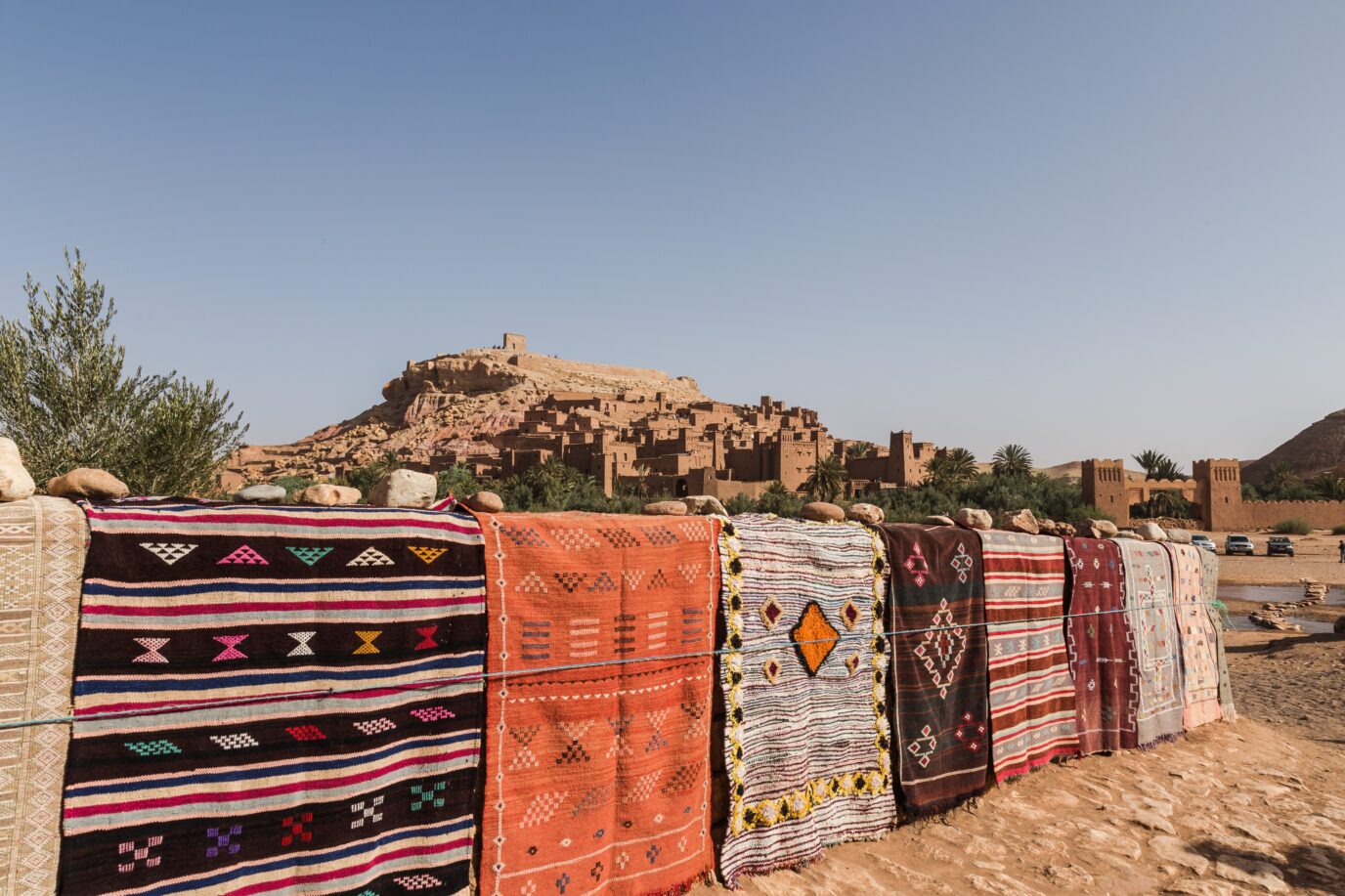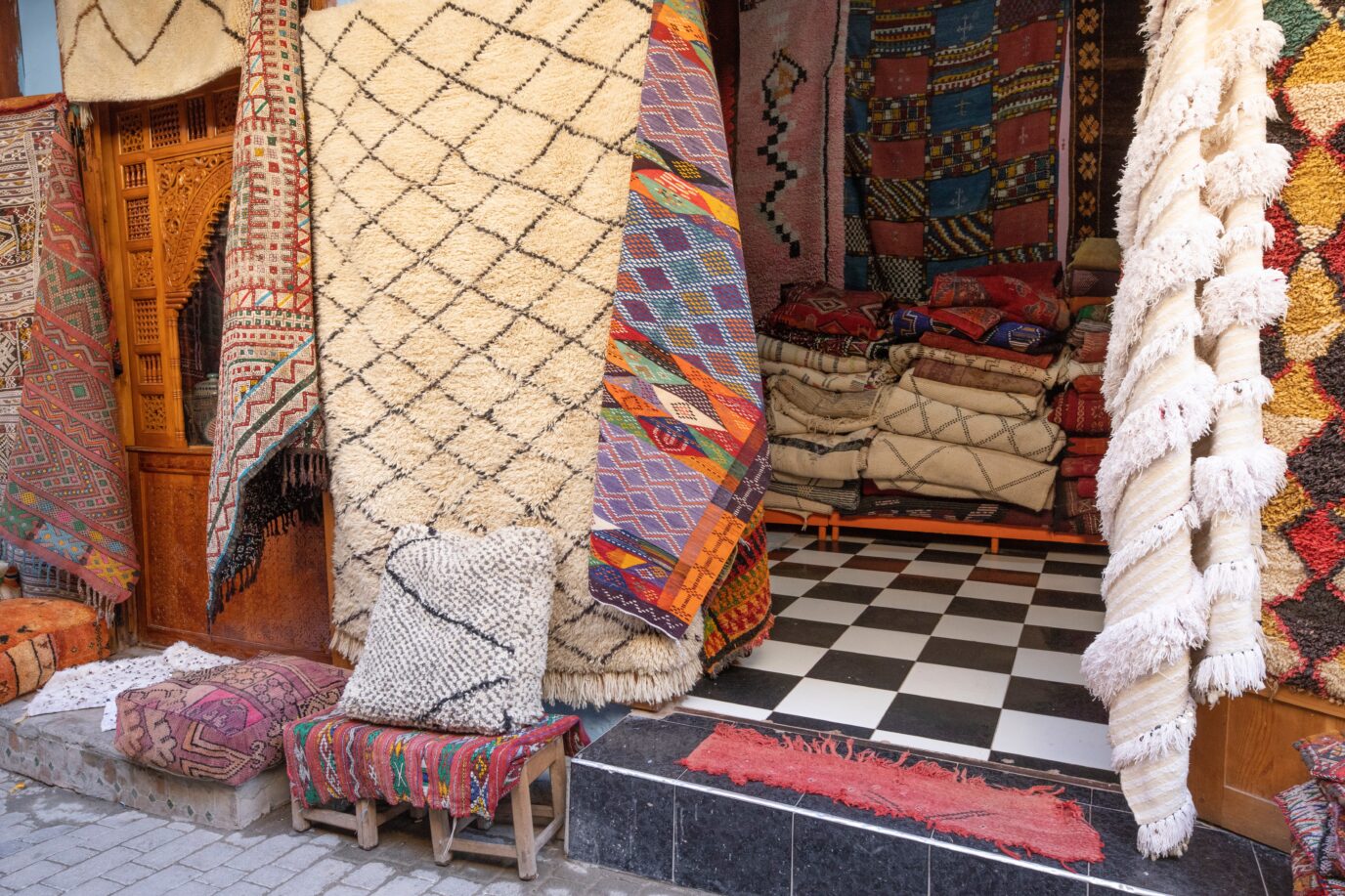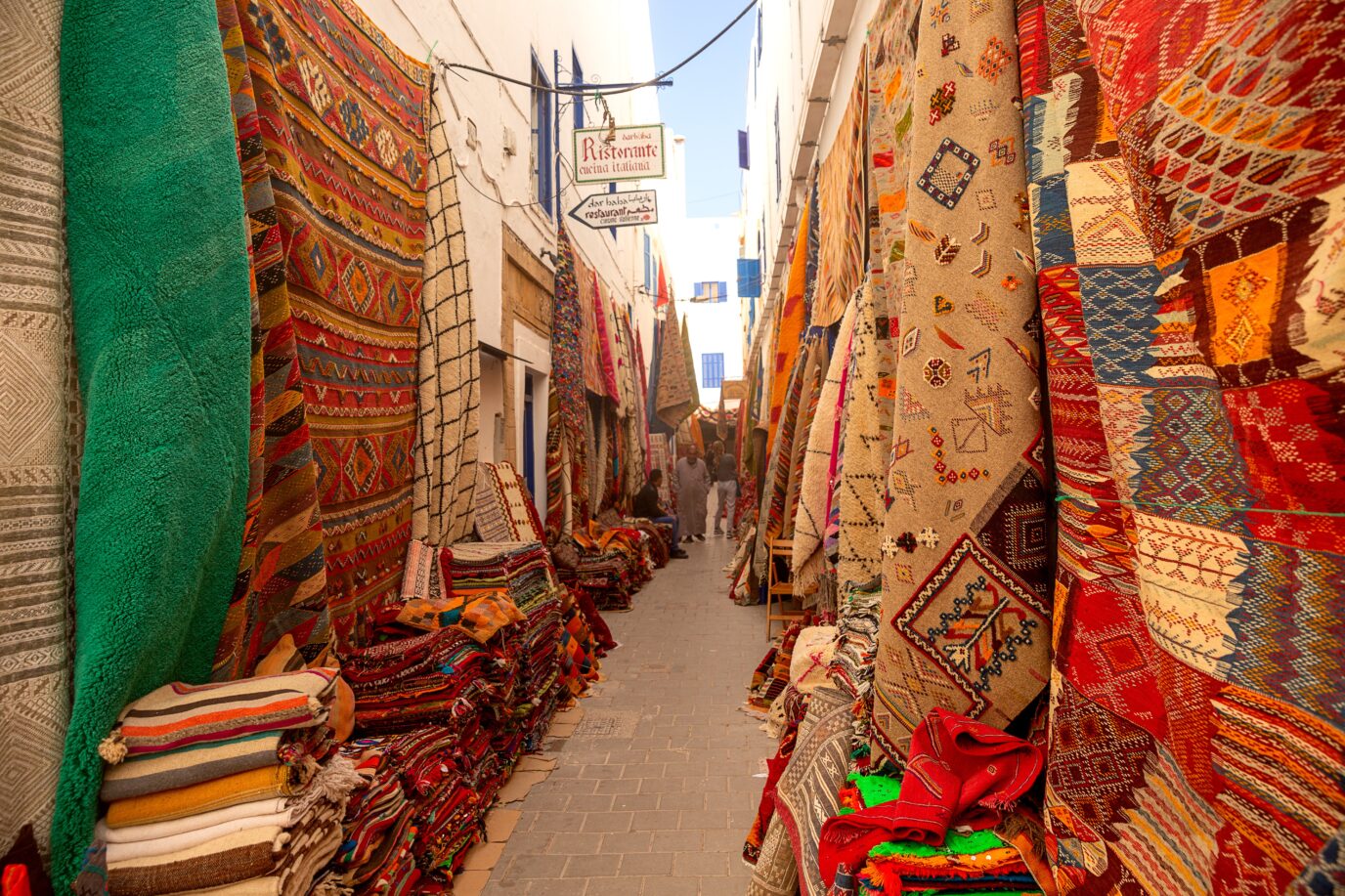Handcrafted Moroccan rugs stand out throughout the Arab and African worlds for their patterns, textures, and richness of colors. They are filled with symbols representing important events, daily life, ancestors, and myths. Their beauty is admired, and ethnographers and art critics derive knowledge about the culture of the people from them.
History of Moroccan rugs
The history of textiles and carpet weaving in Morocco began with the settlement of the country by the Amazighs millennia ago. By the time the Arabs arrived in North Africa in the 7th century, this craft was already highly developed here. Today, there are about 45 Amazigh tribes in Morocco, each of which uses its own carpet-weaving technique, colors, and motifs. Varieties of Moroccan carpets are named after the tribes or regions of their production: Beni Waren, Tazenakht, Bujad, Ulmes, Beni Mgild, Zayan, etc. The works of self-taught masters from remote villages provide an opportunity to look into the culture and soul of the people. They are valuable as decorative items and a source of information about Morocco’s history and folk beliefs.
Moroccan Berber Rugs
Carpet making is mainly done by women in small cooperatives of 15-40 people. Most of them are illiterate, and the skill is passed down from mother to daughter. The production process is entirely manual. The material is most often 100% wool, sometimes with cotton. The highest quality wool is considered to be sheared from a live ram, not from the skin. It is washed in the river, dried in the sun, then combed and spun into threads, and dyed according to the old technology using natural pigments: henna, indigo, ferrous sulfate, and others. The lines are then wound onto the warp of a loom. Before starting work, a short prayer is said.
It takes several weeks to several months to create one carpet; several craftswomen can take part in the work alternately. They perceive the loom as animated and endowed with baraka (blessing). Working on a rug is a whole sacral ritual of interaction with the world of the spirits around us. When weaving woolen threads, it is essential to protect them from negative energy. This is aided by singing, praying, and telling stories as you work. Particular carving motifs on the ridges of the machine are designed to ward off the evil eye and scare away the genies. The carpets themselves have the same designs.
Often asymmetric patterns are created spontaneously, without schemes, and convey the craftswoman’s personal life experience and experiences. Ancient Amazigh symbols show birth, life, and death, as well as natural events and things that happened in the tribe’s life. They also serve as talismans to protect against the evil eye and bring luck, wealth, and good health. The finished product is perceived as a talisman that protects against evil forces.
Meaning of symbols on Moroccan rugs
1) eye – a symbol of protection from the evil eye. The cross drives away evil forces from all four corners of the world;
2) frog – fertility and magical powers;
3) a bird – a positive symbol,
4) skeletons of snakes and fish – a symbol of a holy person and healer;
5) seed – a symbol of fertility;
6) lion’s paw – a symbol of strength; claws – a symbol of protection;
7) crow’s beak – a talisman to protect children;
8) partridge eyes – a symbol of female beauty;
9) saw – a symbol of blacksmiths who drive away genies through work with metal;
10) scissors – a symbol of blacksmiths who drive away genies through work with metal.
Types and styles of Moroccan Rugs
Zemmour and Zaiane
Zemmour carpets are handmade in the territory of the same name between Meknes and Rabat from pure wool or a mixture of wool and cotton. Their characteristic feature is a red or red-orange background with stripes of complex geometric patterns. Ornaments on vintage carpets are simpler. A distinctive feature of Zayan carpets is diamond-shaped patterns, which in the Amazighculture personify the figure of a mother-woman.
Beni Ouarain (Benny Uaren, Beni Uiran)
Beni Waren is the collective name for 17 Amazigh tribes in the Atlas Mountains who raise sheep and goats and lead a traditional way of life in harsh natural conditions.
Beni Waren carpets are easily recognizable by their thick, soft pile of natural white wool and patterns of black or brown lines in the form of diamonds or zigzags. On some carpets, there are patterns-talismans and letters of the Amazigh alphabet.
Initially, they were used as a blanket for sleeping or a cape, not as a decorative floor covering. Their long thick pile was the perfect protection against the cold in the highlands, where temperatures drop to minus 10 in winter.
In the middle of the 20th century, Frank Lloyd Wright, Corbusier, and other Western designers brought Beni Waren carpets to the rest of the world. Their high-quality natural wool, simple design, suitability for modern rooms, and affordable price made them famous far beyond Morocco. They are still handcrafted, and no two are alike.
Azilal
Beni Waren carpets from the province of Azilal have become popular on the mass market since the 1990s. Last century. They differ from Beni Waren in various colors and abstract patterns, all against the same milky white background. They have a slightly less dense pile but are just as soft and comfortable. Such a bright carpet with a design spontaneously created by the craftswoman creates a creative atmosphere in the room.
Boucherouite (Busheruit)
These Moroccan carpets, woven from fabric and old clothes and similar to our grandmother’s rugs, appeared in the 60s and 70s. Last century due to economic changes in the country. Many Amazighs migrated from the mountains to the plains and too big cities, abandoned sheep breeding, and took up agriculture and trade. The need to decorate the home did not disappear. Low-income families began making bright, pretty rugs from fabric instead of woolen carpets. This is how “patchwork carpets” (the literal translation of “boucheruit” from Arabic) appeared.
Due to the size of the knots, weaving them is straightforward and quick. These carpets were created purely for home decoration and not for sale. Boucherouite is trendy in Morocco due to its avant-garde style, vivid colors, and the belief that reusing materials is healthy for the environment.
The style of these carpets embodies creative energy and sincere homely simplicity and comfort. We advise you to look at the Boucheruit Carpet Museum in Marrakech, where the Frenchman Patrick de Maillard has amassed a collection of 300 creations of this genre.
Handira
Strictly speaking, a hendira is not a carpet but a cape made of wool (sometimes with the addition of cotton and silk). Still, they are often sold in the same stores along with carpets. Amazigh women from the Middle and High Atlas mountains made these beautiful bedspreads for their daughters as a dowry. As a rule, hendira is decorated with geometric patterns in natural beige or black colors, but there are also color options. Its surface is often embroidered with sequins that ward off the evil eye and bring prosperity. At traditional Amazigh weddings, you can still see how the bride covers her head with a hendira on her way to her husband’s house. This cape, made by the woman in her family, should keep the bride warm and protect her from bad luck.
Today they are more used to decorating interiors. A thick, densely woven wool hendira can be used as a carpet. Lighter models can serve as a bedspread, sofa throw, or wall decoration.
How to choose and buy a Amazigh rugs in Morocco
Traveling around the country, you will definitely get to the carpet market. The variety of goods is so great, and the sellers are so skillful that it is tough to resist buying. However, spontaneous shopping is dangerous because you can overpay several times more or buy something completely different from what you need. We share tips on how to make the right choice and avoid mistakes when purchasing.
Prepare to buy in advance
Decide on the carpet’s size, style, and price before arriving in Morocco. Please take a picture of the interior for which you are purchasing it. Check out the types and styles of Moroccan rugs on online platforms like Etsy or Pinterest. Save your favorite photos to your phone and show the seller in the store. This will save time because you must choose from hundreds of options! When buying on the spot in Morocco, prices should be at least a third or even half less than in online stores.
Decide which carpet you want to buy: machine-made or handmade?
In the first case, you will spend from 20 to 200 $ in the second – from 200 to several thousand. Perhaps it makes no sense to overpay for manual work if you want to create an ethnic accent in the interior?
Be prepared to haggle “like a Amazigh”
The actual price of the carpet will be at least 2 times less than the original, and often several times. In some shops (large craft centers in big cities), the prices are fixed, which will be communicated to you at the beginning of the visit. You can start with them to get an idea about the types and costs of carpets. But it is better to buy in the market where there is an opportunity to bargain. You must follow your word if you have already agreed on the price.
Where is the best place to buy a Moroccan carpet?
There are numerous varieties of carpets, and each region has its own production method. Merchandise from around Morocco can be found at the bazaars of Marrakech and Fes. But the more significant the store, the higher the prices are because they have to sell their goods through a chain of resellers and share a commission with street vendors, guides, hotels, and Riads. So, if the price is the most important, buy carpets in small towns and villages or small shops that don’t sell to tour groups. It is essential to understand that, in this case, the delivery of goods to the house will have to be dealt with independently. Try not to buy carpets from women’s cooperatives. Despite the relatively high prices, the women who work in them receive only a small fixed salary, and the primary profit from the sale goes to the seller.
If you want to buy a vintage or collectible carpet, become an expert in the field before making a purchase, or take an expert you trust to shop.
There are many technologies for “aging” a carpet to pass it off as vintage and sell it for thousands of euros more. Only some tourists understand the craft’s intricacies, and sellers are willing to use this. An actual vintage carpet will be slightly faded and worn because it has served for many decades. To find out how much something costs, it’s essential to know where, when, and how different carpets were made. To do this, you will have to re-read a lot of unique literature!
Check the quality of the material when buying
Most handmade carpets are made from 100% wool, sometimes with cotton. Factory-made carpets often contain synthetics. You can check if there are synthetics in the composition with a lighter. Ask the seller to set fire to the fringe of the carpet. Natural wool will not catch fire or go out immediately. Look at the rug’s underside – uneven knots indicate it is handmade.
Immediately agree on the delivery of the carpet to your country.
In big stores, shipping may be included. Please photograph your purchase, receipt, and store, and note the carpet’s dimensions. Business card:
Save it
Save the seller’s business card.
Pay by card because, in case of a conflict situation, it will be possible to request the cancellation of the operation from the bank.
A small carpet is cheaper to send as extra luggage on the plane – you’ll be surprised how compact it can be packed in a store! Independent international shipment by Moroccan mail will cost an average of 200-400 $.
How to know if a Berber carpet is real?
Determining if a Berber carpet is authentic requires paying attention to several key factors:
Origin
The Moroccan rugs spreads in North Africa, especially in regions inhabited by Amazigh tribes like Morocco.
Knowing the origin of the carpet may provide clues to its quality.
Materials
Authentic Berber carpets are traditionally hand-woven by Berber women using natural materials such as sheep wool or camel hair. Synthetic materials are generally not used in genuine Berber carpets. Check the texture and feel of the carpet to determine if it is made from natural fibers.
Weaving technique
Berber carpets are hand-woven using traditional techniques passed down from generation to generation. The weaving process often results in slight irregularities and variations in the pattern, which adds to the authenticity of the carpet. Carefully examine the weaving pattern to see if it exhibits these characteristics.
Design and patterns
Berber carpets are known for their geometric patterns and distinctive symbols, which often have cultural significance. These patterns can vary depending on the tribe and region where the carpet was made. Authentic Berber carpets feature unique patterns that reflect the heritage and craftsmanship of the Berber people.
Knot density
While not always a definitive indicator of authenticity, knot density can provide insight into the quality and craftsmanship of a Berber carpet. Generally, higher knot densities indicate more refined craftsmanship and may suggest a more authentic and valuable carpet.
Seller reputation
Buying from reputable sellers or dealers specializing in authentic Berber carpets can help ensure that you are getting an authentic product. Research the seller and ask questions about the origin, materials, and craftsmanship of the carpet before making a purchase.
Price
Authentic Berber carpets are handmade and may require a lot of labor, so they tend to be more expensive than machine-made or mass-produced carpets. Beware of unusually low prices, as they may indicate a counterfeit or inferior quality product.
Frequently Asked Questions
What is special about Moroccan rugs?
People love Moroccan rugs because they have unique patterns, bright colors, and complex textures. These rugs were made by skilled craftspeople using techniques passed down for generations. A group called the Beni Ourain makes rugs in the Atlas Mountains. These rugs are known for their soft wool and neutral colors. Boucherouite rugs, on the other hand, are made from old fabrics and have bright colors and unique designs. Moroccan rugs are very popular with collectors and furniture designers worldwide because of how beautiful and well-made they are.
How much is the average rug in Morocco?
The cost of a Moroccan rug depends on its size, style, material, and quality. Large, high-quality rugs can cost several thousand dollars. People often haggle in Morocco, meaning the final price relies on how well you can negotiate and how flexible the seller is.
Are Moroccan rugs expensive?
The price of a Moroccan rug depends on its size, material, quality, and design. For bigger, better-made pieces, the price can go up to several thousand dollars. People in Morocco often haggle, which means that the final price relies on how well you can negotiate and how flexible the seller is.
Why are Moroccan rugs so expensive?
Because of these things, Moroccan mats can be pricey:
- Many Moroccan rugs are made by skilled craftspeople using old methods that take a long time. For example, it might take a few months to tie each knot by hand on a big, good rug. Because this process takes a lot of work, the end price of the rug may go up.
- Many Moroccan rugs are made from expensive, high-quality materials like silk and wool. Some rugs may also have natural colors, which cost more than synthetic dyes.
- Moroccan rugs are famous for their unique designs, which often include bright colors, complex textures, and large geometric shapes. These patterns are often the result of years or even generations of artistic practice. Making them can be difficult and take a long time, raising the price of the finished rug.
- Because Moroccan rugs are so popular with collectors and furniture designers worldwide, their prices can increase because of supply and demand.
There are some expensive Moroccan rugs, but there are also many that aren’t too expensive. A rug’s price relies on many things, such as its size, materials, quality, and design.







